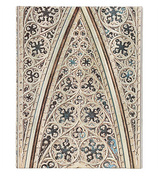Pink is a hue widely used in kimono for hundreds of years. It's not just any old color, but rather it symbolizes femininity and elegance which are two things associated with women in Japanese culture. Pink is the color of romance and femininity. It's also a symbol of healing to comfort women.
JOURNAL
- Measures 7"W x 9"L x 0.5"D
- Interior: Lined
- 176 pages
- Paper Weight: 100
- Binding: Smyth Sewn
- Smooth
- No Closure
- Soft cover
- Edge Printing
- Back Cover Pouch
- Ribbon marker
- Decorative printed cover paper
- FSC-certified text paper
- Threaded stitching and glue, as needed
- Cloth headbands
- Acid-free sustainable forest paper
- Flexible cover and spine
- Complex imagery
- Original Art: Kimono
- Era: Edo Period
- Region: Japan
Showcasing silk dyed with beni (the pigment extracted from safflower petals) and lacquered in gold, this kimono design dates to the Edo period (1615–1868).
It was originally used as a costume for the theatrical style known as Noh. Karaori refers specifically to the exquisitely embroidered woman’s kimono that traditional Noh theatre was known for. Both the material itself and the pattern depicted would have helped tell the story of the character. In this case, the stiff brocade creates a thick, glossed fabric that would not drape easily – this created an angular effect evoking the spirit of a noblewoman. The pattern of flowering grasses emphasized the character’s femininity.
By the Meiji period (1868–1912) Noh had reached such heights that it was widely introduced overseas, and today there are still more than 70 Noh theatres throughout Japan. This beautiful example of karaori costuming can now be found at the Art Institute of Chicago. It is our great pleasure to work with such a gorgeous and culturally important piece of history to craft this journal design.









